 As mentioned in our prior recap of the Green Building Focus Conference, Eric Corey Freed of Organic Architect was the final keynote speaker. Eric has a reputation for stirring the pot and with a title of his keynote being Dodo Sapiens: How regenerative, bio-based buildings will save us from ourselves, one can tell he is keeping the tradition alive. With that said, with his self-deprecating style, one can’t help but laugh & pay attention to see what he is going to do next. Another interesting item is that he makes all his presentations available on his site and (be forewarned they are large – this one is almost 95 MB & contains 387 pages of slides).
As mentioned in our prior recap of the Green Building Focus Conference, Eric Corey Freed of Organic Architect was the final keynote speaker. Eric has a reputation for stirring the pot and with a title of his keynote being Dodo Sapiens: How regenerative, bio-based buildings will save us from ourselves, one can tell he is keeping the tradition alive. With that said, with his self-deprecating style, one can’t help but laugh & pay attention to see what he is going to do next. Another interesting item is that he makes all his presentations available on his site and (be forewarned they are large – this one is almost 95 MB & contains 387 pages of slides).
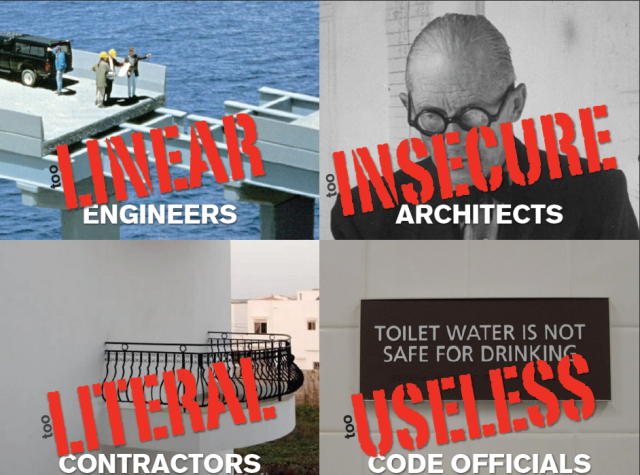
Sorry I couldn’t help but through that slide in which relates to his description: This new talk for 2012 explores how we are all victims of our own stupidity. Seemingly harmless decisions about our buildings made decades ago and now throwing all of our natural systems into decline. By learning from Nature, we’ll uncover lessons to apply to our built environment that will save energy, water, resources and be healthier in the process. As one might imagine trying to cover everything that was covered in an hour would be almost impossible, so I wanted to focus on just one item he brought up…
Building Codes:
Ahhh building codes, meant to ensure one’s health and safety…but yet we still require hot water taps on every sink in commercial buildings, and if your building is X size, you must have a total of Y parking slots and of course Z handicapped spots.
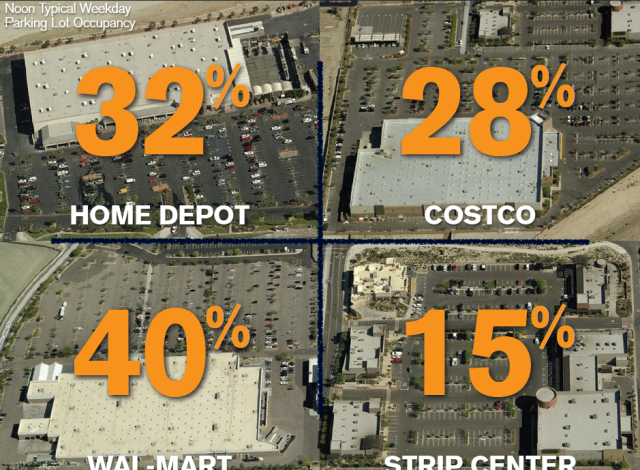
Needless to say, that sure is a ton of asphalt that is required.
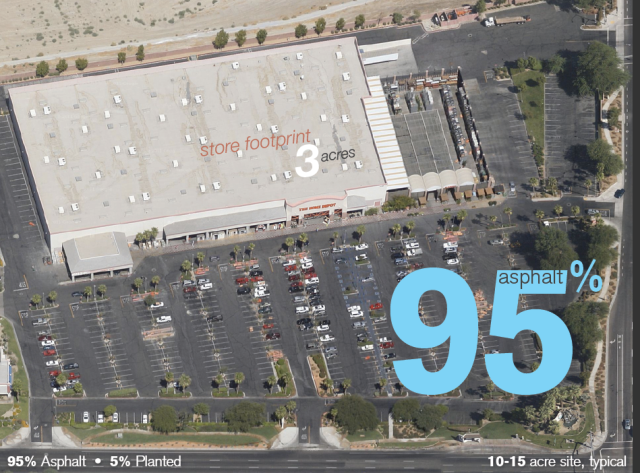
So what happens if we changed the materials? Being from Arizona, I can tell you that the difference is amazing not only when walking across the different materials, but even the interior temperature of the car is noticeably lower.
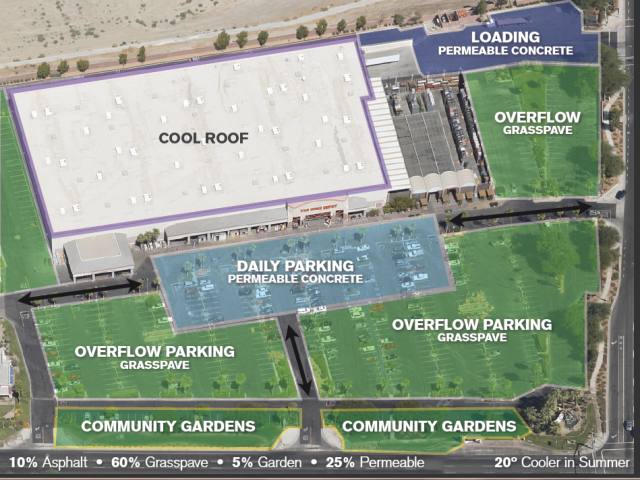
Want to get more radical – what happens if we actually moved where the “overflow” / employee parking is.
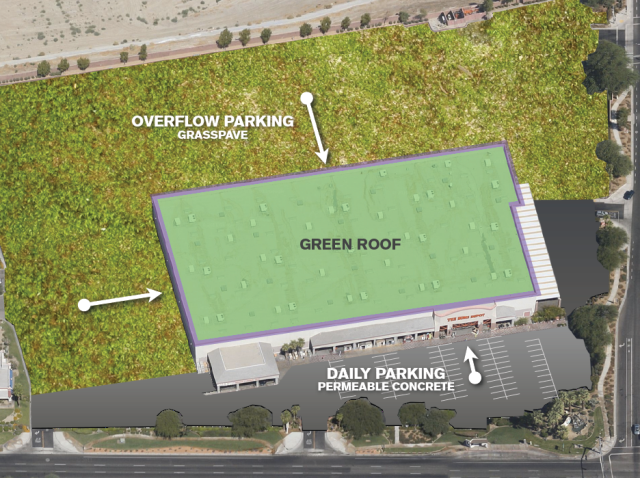
Now I must point out two small issues I did notice, the first is that the loading area being done with Permeable concrete aka pervious concrete won’t really work that well in that situation (hey what can I say, he’s an architect, not an engineer or builder). The second issue is that if someone chooses to go this route, they would need a loading zone for customers that might be parked out there (especially if they use shopping carts). On the bright side, customers like these areas especially if it is a real hot sunny day, rainy or snowing. Ok I lied, the third point is if done right, the place will look better than is shown below.
Misc. Thoughts:
One item Eric said, pretty well sums up many of those giving the different presentations (remember the theme is on rebuilding) “We have been going about it all wrong. We have been throwing panels and other features on traditional houses and saying the payback is worth it, instead of building green from the start.” One of the biggest retweeted tweets of mine was along the lines of “if you want Net-Zero start here http://passipedia.passiv.de/passipedia_en” This sentiment of building houses to passively heat and cool themselves, was brought up by at least 4 of the speakers as the first step.
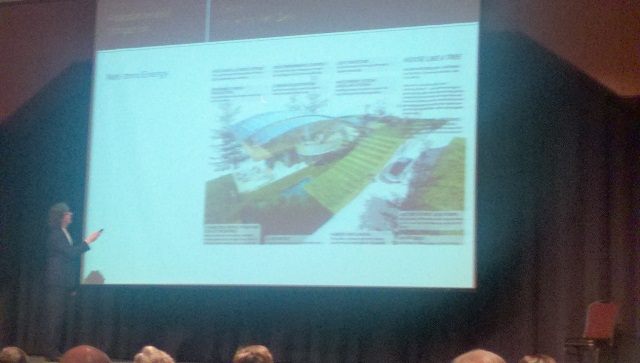
Both Eric & Llewellyn brought up regenerative / resilient homes ( sorry about the blurry picture above from Llewellyn’s presentation – there are also quite a few images in Eric’s slides) or what some would call earth sheltered / living walls. While this option is doable, you need to make sure that not only are all the details perfect and the owners are ready for the maintenance required.
In closing, I would like to thank Eric for graciously allowing us the use of the slides and everyone that participated in the GBCF this year. It was a great two days of learning, meeting up with old friends, making new ones, and in a way recharging my batteries.

Dodo Sapiens! Where to begin with that?
I recently toured the office of a client of ours, who is a leading sustainable landscape architect and planner. They redesigned their entire office in an environmentally friendly way through construction techniques and materials used. The landscape is all native plantings and the parking is all permeable surface, whereas the runoff serves to irrigate certain garden portions of the property. Smart and sustainable design is possible and practical. I was impressed by the fact that the local sewer district commended him as a pioneer in this type of design, which shows just how little implementation has been done through our city.
GBFC appears to have been a valuable conference. Thanks for sharing a bit of it here.
Dodo Sapiens! Where to begin with that?
I recently toured the office of a client of ours, who is a leading sustainable landscape architect and planner. They redesigned their entire office in an environmentally friendly way through construction techniques and materials used. The landscape is all native plantings and the parking is all permeable surface, whereas the runoff serves to irrigate certain garden portions of the property. Smart and sustainable design is possible and practical. I was impressed by the fact that the local sewer district commended him as a pioneer in this type of design, which shows just how little implementation has been done through our city.
GBFC appears to have been a valuable conference. Thanks for sharing a bit of it here.